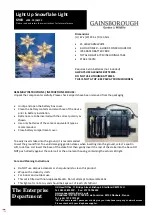
ZM-AH02E
DELTA 4000
35
3 TESTING POWER SYSTEM COMPONENTS
Cables
Cables rated for operation at 5 kV and above are usually
shielded by a metal cable sheath. Measurements for this
type cable are made by the GST GROUND test method
and are confined to the insulation between the conductor
and the sheath. The high-voltage lead is connected to the
cable conductor and the cable sheath solidly connected to
the same grounding system as the test set.
When testing three conductor cables which have a single
metal cable sheath, UST tests should be made between each
conductor combination with the remaining cable ground-
ed. A second set of tests should be made between each
conductor and ground with the remaining two conduc-
tors guarded (GST test with guarding). A third test should
be made between all conductors connected together and
ground (GST GROUND test). This test procedure is simi
-
lar to that when testing three winding transformers.
The test set measures the average dissipation factor of the
cable; therefore, if a long length of cable is measured, an
isolated section of cable having an abnormally high dissipa-
tion factor may be completely masked and have no signifi
-
cant effect on the average value. Thus, the ability to detect
localized defects will diminish as the cable length increases.
Tests on long lengths of cable give a good indication of the
inherent dissipation factor of the insulation and when com-
pared with previous tests or measurements on similar cable
may reveal potential problems due to general deterioration,
contamination, or moisture penetration.
Cables are inherently of relatively high capacitances per unit
length (0.5uF per phase per mile / 0,3 uF per phase per
km) so that for long lengths the kVA capacity of the test set
power supply may be exceeded. Refer to Section 3, Specifi
-
cations, for maximum specimen capacitance measurable at a
particular test voltage.
Surge (lightning) arresters
Introduction
The purpose of a surge (lighting) arrester is to limit the
over voltages that may occur across transformers and other
electrical apparatus due either to lightning or switching
surges. The upper end of the arrester is connected to the
line or terminal that has to be protected, while the lower
end is solidly connected to ground. The arrester is com-
posed of an external porcelain tube containing an ingenious
arrangement of stacked discs (or valve blocks) that are
composed of a silicon carbide material known by trade
names such as thyrite, autovalve, etc. This material has a
resistance that decreases dramatically with increasing volt-
age. Arresters are effectively switching devices that serve
as an insulator under normal conditions and as a conduc-
tor under over voltage conditions. After an over voltage
condition is cleared the arrester must return to its normal
insulating condition. The measurement of power loss is an
effective method of evaluating the integrity of an arrester
and isolating potential failure hazards. This test reveals
conditions which could affect the protective functions of
the arrester, such as: the presence of moisture, salt deposits,
corrosion, cracked porcelain, open shunt resistors, defective
pre-ionizing elements, and defective gaps.
A complete test on a surge arrester involves impulse and
overvoltage testing as well as a test for power loss at a
specified test voltage using normal 50/60 Hz operating
frequency. Impulse and overvoltage testing is not generally
performed in the field since it involves a large amount of
test equipment that is not easily transportable.
To evaluate the insulation integrity of an arrester, measure
the power loss (watts-loss or dissipation factor) at a speci
-
fied voltage and compare it with previous measurements
on the same or similar arrester. Measurements on a surge
arrester should always be performed at the same or recom-
mended test voltage since nonlinear elements may be built
into an arrester. When using this test set, all measurements
should normally be made at 10 kV. Except for the spe-
cific purpose of investigating surface leakage, the exposed
insulation surface of an arrester should be clean and dry to
prevent leakage from influencing the measurements.
Some types of arresters show a substantial temperature
dependence, while others show very little dependence.
Temperature correction curves for each arrester design
should be carefully established by measurement, and all
measurements should be temperature corrected to a base
temperature, usually 20
°
C. The temperature measurement
should be based on that at the arrester surface. The air
temperature should also be recorded. The surface of the
arrester should be at a temperature above the dew point to
avoid moisture condensation.
It is recommended that tests be made on individual arrester
units rather than on a complete multi-unit arrester stack. A
single arrester unit can be tested by the normal ungrounded
specimen test (UST) in the shop; however, it can only be
tested by the grounded specimen test (GST) when mounted
on a support structure in the field. Table 3.11 shows the
recommended test procedure for testing installed multi-unit
Summary of Contents for DELTA 4000
Page 2: ......
Page 5: ...ZM AH02E DELTA4000 5...
Page 9: ...ZM AH02E DELTA4000 9 1 Introduction...
Page 15: ...ZM AH02E DELTA4000 15 2 Interpretation of measurements...
Page 43: ...ZM AH02E DELTA4000 43...
Page 46: ...46 DELTA4000 ZM AH02E...
Page 47: ...ZM AH02E DELTA4000 47...














































